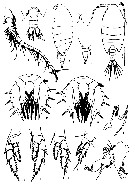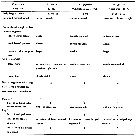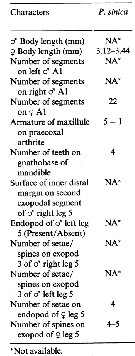
Issued from : G. Lian & H. Qian
in Acta Oceanol. Sinica, 1994, 13 (4). [p.551, Fig.1].
Female (from South China Sea): 1-2, habitus (dorsal and lateral, respectively); 3, corners of last thoracic segment and urosome (right lateral view); 4, rostrum with rostral filaments (frontal view); 5, left A1 (dorsal); 6, left Md (cutting edge); 7, left Mx1; 8, left P1 (anterior surface); 9, left P2 (anterior surface); 10, left P3 (anterior surface); 11, left P4 (posterior surface); 12, P5 (anterior surface); 13, last thoracic segment and urosome (dorsal); 14, P5 (anterior view).
Holotype: 1-12 (from 33°00'N, 124°50'E); paratype: 13-14 (from 20°00'N, 111°25'E).
Nota: Cephalosome and 1st pedigerous segment separate, 4th and 5th segments completely fused.
Each side of the posterior margin of the last thoracic segment with one acute dorsolateral and another acute ventrolateral processes; both sides slightly asymmetrical, the left ventrolateral process longer than the right one, former reaching nearly the end of genital segment, the latter only reaching the middle or 2/3 of the genital segment.
Urosome 4-segmented.
Genital segment asymmetrical, right side rather swollen on the proximal and with fusion line clearly visible on the dorsal middle to right lateral margin.
Anal segment very short.
Caudal rami somewhat asymmetrical, left ramus broader; the 3rd and 4th caudal setae coarser and longer.
A1 22-segmented; segments 1-8 bearing a row of long hairs along the posterior margin. Left A1 longer than the right one, extending to the end of the cephalosome.
A2 exopod 6-segmented; endopod 2-segmented.
Md: cutting edge bifurcated, having a strong ventral tooth, and 3 dorsal teeth of which proximal bearing 2 tufts of spinules; palp having 1-segmented rudimentary endopod, and with 2 setae of unequal lengths on the end.
Mx1: 1st inner lobe with 5 strong spines and 1 spinule; 2nd inner lobe only with 1 long seta; outer lobe with 8 setae; endopod 1-segmented, small knob-like and with 2 small setae of unequal lengths on the tip; exopod 1-segmented and fused with basipod segment 2, wing-like and bearing 3 long apical setae.
Setation and spinulation of Mx2 and Mxp as in
P. japonica.
P5 with endopod and exopod 1-segmented, in former fused with basipod segment 2 and bearing 4 plumose setae; the latter separated from the basipod segment 2, with 3 or 4 outer marginal and 1 terminal spines, as well as one terminal process.






